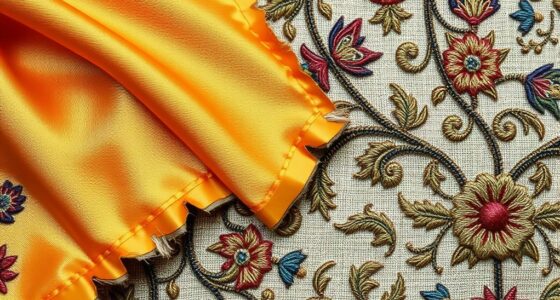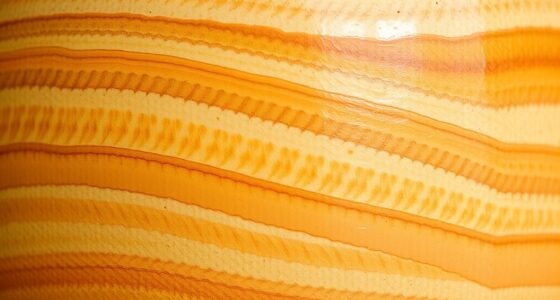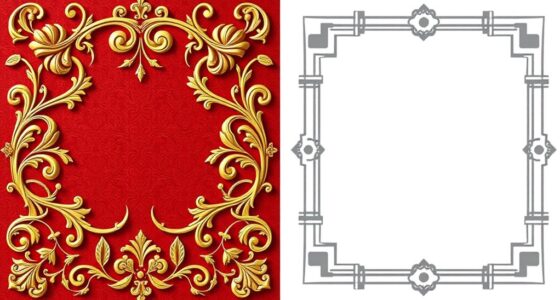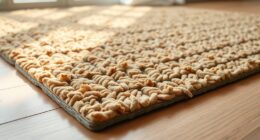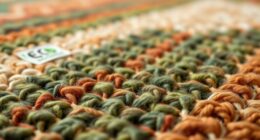To guarantee you’re getting true quality in a $10K rug, look for natural fibers like wool or silk that feel plush, and check pattern symmetry and knot density for fine detail. Examine the backing and foundation for strength, ensuring tight weaving and durable materials. Assess color consistency and dye quality for vibrancy and permanence, and verify provenance and certification for authenticity. If you explore further, you’ll uncover the essential signals that guarantee your investment’s lasting value.
Key Takeaways
- Examine material quality, craftsmanship details, and surface feel to ensure authenticity and luxury.
- Check knot density, pattern precision, and back inspection for durability and fine craftsmanship.
- Assess backing strength, foundation material, and edge reinforcement for long-term stability.
- Inspect color uniformity, dye quality, and resistance to fading or bleeding to verify dye craftsmanship.
- Confirm provenance, certification, and design authenticity to ensure value and cultural integrity.
Material Quality and Texture
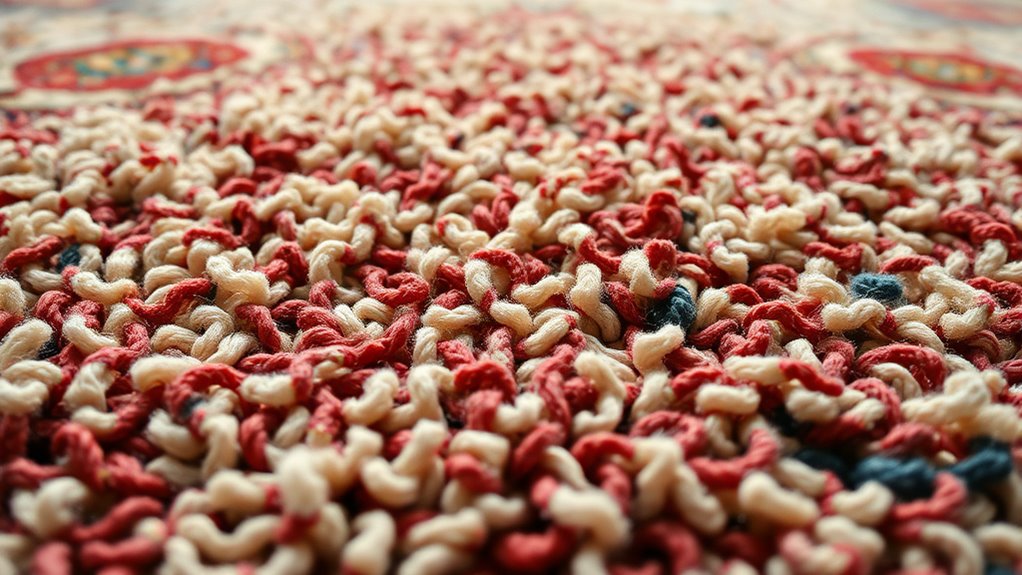
When evaluating a $10,000 rug, the material quality and texture are among the most important factors to contemplate. You should examine the fiber type—natural fibers like wool, silk, or cotton often indicate higher quality. Feel the surface: a luxurious rug has a soft, smooth texture that feels plush under your hand. Avoid rugs that feel coarse, brittle, or overly stiff, as these suggest inferior materials or poor craftsmanship. Check for consistency in the fibers; a quality rug maintains uniformity throughout. Authentic materials tend to age gracefully, developing a rich patina over time. Keep in mind that the texture not only affects appearance but also durability and comfort. By paying close attention to these details, you ensure your investment offers both beauty and longevity.
Knot Density and Tightness
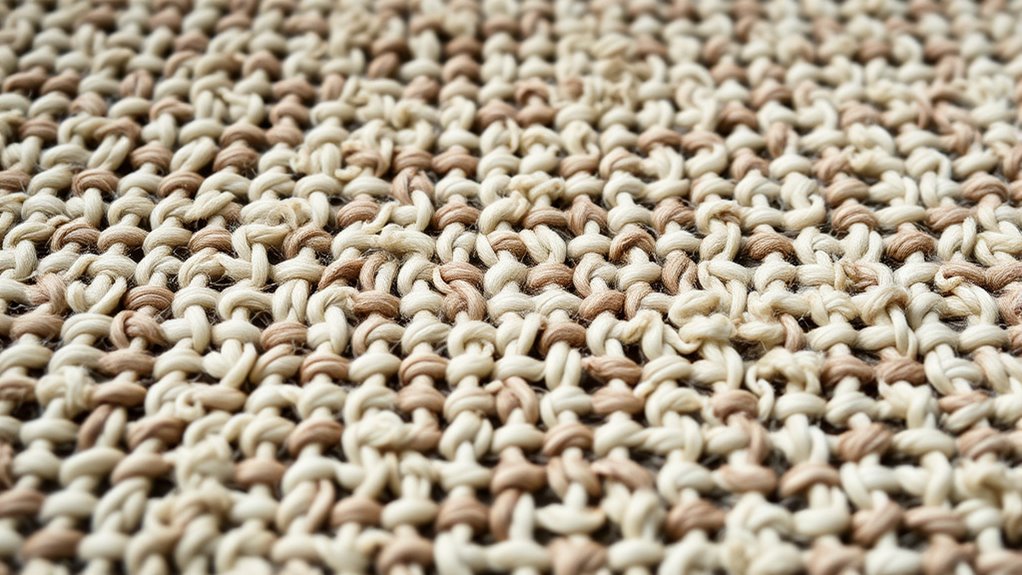
Knot density and tightness are essential indicators of a rug’s quality, directly affecting its durability and appearance. Higher knot density means more knots per square inch, resulting in a finer, more detailed design and increased strength. When inspecting, look closely at the back of the rug—tight, uniform knots indicate craftsmanship and durability. Loose or uneven knots can lead to unraveling over time and diminish the rug’s overall look. You should also feel the rug’s surface; tight knots create a smooth, firm texture, while loose knots feel softer and less structured. Remember, a densely knotted rug not only lasts longer but also showcases intricate patterns with sharp clarity, making it a worthwhile investment. Knot tightness is a clear sign of quality craftsmanship that stands the test of time. Additionally, understanding the knot density can help you assess the overall construction quality and value of the rug.
Symmetry and Pattern Precision

Symmetry and pattern precision are key indicators of a rug’s craftsmanship and overall quality. When examining a high-end rug, look closely at the design to verify it’s evenly balanced and consistent throughout. Flaws or irregularities can signal hurried or careless work. To evaluate pattern precision effectively, focus on these aspects:
Meticulously check for symmetry and uniform pattern details to ensure high-quality craftsmanship in your rug.
- Check if motifs align perfectly at the edges and across the field.
- Observe whether repeating patterns are uniform, with no distortions or mismatched elements.
- Look for any asymmetry, which can suggest inferior craftsmanship or uneven tension during weaving.
- Pay attention to weaving techniques, as meticulous techniques contribute to the pattern’s overall accuracy and durability.
A well-made rug will display meticulous attention to pattern details, with symmetry that enhances its visual harmony. This consistency reflects the skill of the artisan and the quality of the piece.
Backing and Foundation Strength
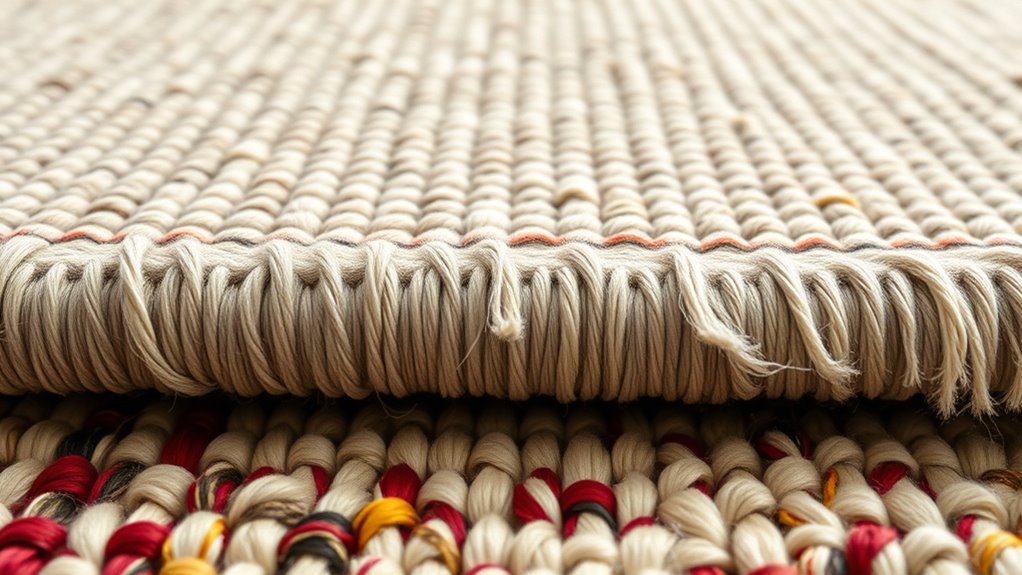
You should examine the rug’s core support to guarantee it’s sturdy and well-constructed. Check the materials used for durability and how properly the framing techniques are applied. A strong backing and foundation are vital for long-lasting value and quality. Ensuring that the support structure is robust can significantly affect the rug’s overall stability and lifespan.
Rug’s Core Support
The foundation of a high-quality rug is its core support, which includes the backing and the foundation that hold the fibers securely in place. A strong core guarantees durability and shape retention over time. To assess this, look for:
- Tightly woven foundation: The base should feel dense and firm, indicating it’s well-constructed.
- Consistent knot density: Higher knot counts often mean a sturdier foundation that maintains its integrity.
- Proper backing material: A quality backing, like cotton or silk, should be securely attached without loose threads or gaps.
These elements work together to provide the structural support that keeps your rug looking pristine and lasting for years. Always inspect the foundation carefully before making your investment.
Material Durability Checks
Since the backing and foundation are critical to a rug’s durability, it is vital to examine their material strength carefully. Look closely at the backing material—high-quality rugs often feature a sturdy, well-stitched foundation that resists fraying and unraveling over time. Check for even, tight weaving without loose threads or gaps. The foundation, usually made of cotton, wool, or synthetic fibers, should feel dense and firm when you press on it. Weak or flimsy backing indicates poor construction, which can lead to premature damage. Additionally, ensure the rug’s edges are securely bound and reinforced, preventing unraveling. Testing the backing’s strength and foundation quality helps you avoid a rug that will deteriorate quickly, guaranteeing your investment remains beautiful and functional for years. Material durability checks are essential in assessing the overall quality and longevity of a fine rug.
Proper Framing Techniques
Proper framing techniques are essential to guarantee a rug’s backing and foundation can withstand daily wear. When evaluating a high-quality rug, check that the framing is tight and even, preventing edges from fraying or loosening over time. A well-framed rug maintains its shape and durability longer. To assess framing quality, look for these key indicators:
- Consistent Stitching – Ensure the stitches are even and secure around the edges, without gaps or loose threads.
- Reinforced Corners – Check that corners are reinforced, preventing unraveling from frequent foot traffic.
- Proper Backing Material – Confirm the backing is sturdy, well-attached, and compatible with the rug’s construction, providing support and stability.
- Material Durability – Consider the material quality used in the backing and framing, as superior materials contribute to a longer-lasting rug.
Focusing on these details helps you select a rug built to last.
Color Consistency and Dye Quality
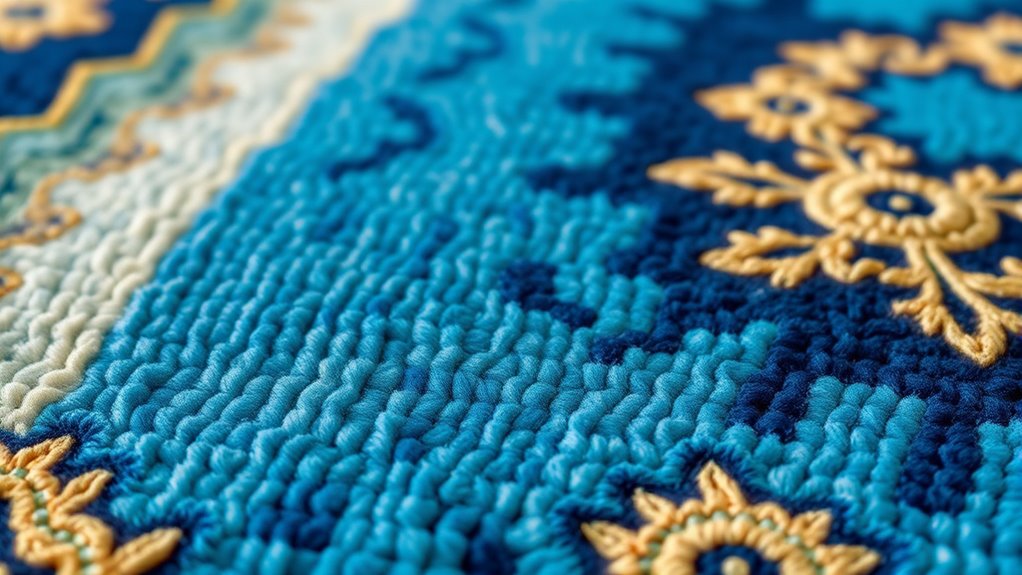
Ensuring color consistency and dye quality is essential when evaluating high-end rugs, as uneven or fading colors can substantially diminish their value. High-quality rugs use natural dyes that produce rich, vibrant, and stable colors. Check for uniformity across the entire rug; inconsistencies may indicate poor dyeing techniques. Fading or bleeding colors suggest inferior dyes or improper washing. To assess dye quality, look at the back of the rug—colors should match the front without smudging. Here’s a quick guide:
| Aspect | What to Look For | Why It Matters |
|---|---|---|
| Color Uniformity | Consistent hues across the rug | Indicates good dyeing process |
| Fading | Minimal fading over time | Sign of high-quality dyes |
| Bleeding | No color transfer when touched | Ensures dye stability |
| Natural Dyes | Rich, earthy tones | Sign of craftsmanship |
| Synthetic Dyes | Bright, unnatural colors | Lower quality, less durable |
Additionally, dye fastness is crucial to ensure that colors remain vibrant despite exposure to light and washing, which is a hallmark of well-crafted high-end rugs.
Craftsmanship and Workmanship Details

Careful attention to craftsmanship and workmanship details reveals the skill and precision behind a high-quality rug. When inspecting a $10K rug, look for signs of expert hand-knotting and finishing. Here are key indicators:
- Symmetry and Consistency: Check that patterns align perfectly across the rug, showing meticulous planning and execution.
- Knot Density: Higher knot counts per square inch indicate detailed work and durability—look for tight, uniform knots.
- Finish and Edges: Examine the finishing touches, like neatly bound edges and secure fringes, which reflect craftsmanship care.
- State-Specific Regulations: Understanding the state-specific tax laws can influence your overall investment and cost considerations when purchasing high-end rugs.
These details reveal the artisan’s expertise and the rug’s overall quality, ensuring you invest in a piece that combines artistry with longevity.
Provenance and Certification
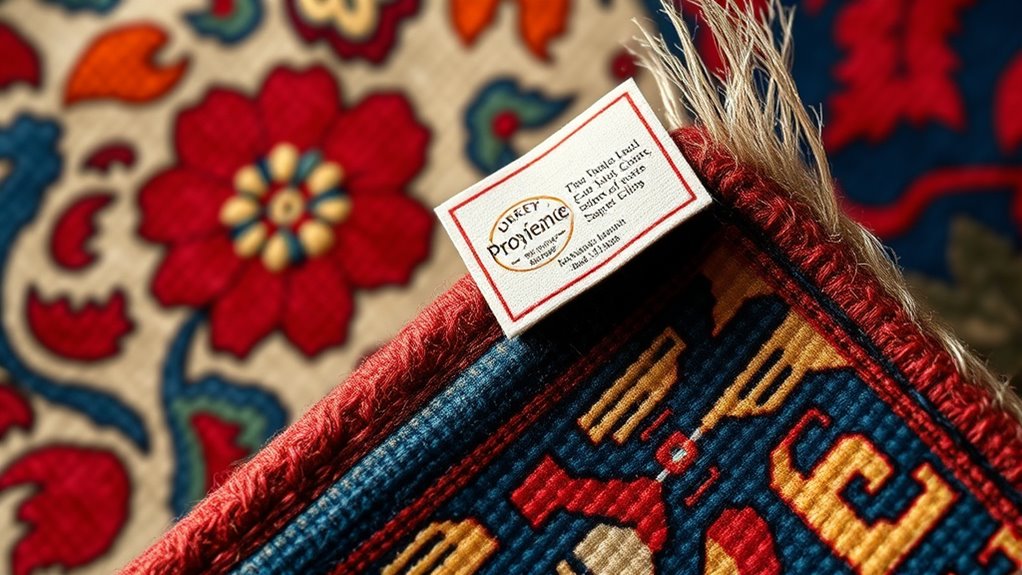
Knowing the provenance and certification of a $10K rug provides essential assurance of its authenticity and value. Provenance traces the rug’s history, revealing where it was made and its previous ownership. This history can confirm it’s genuine and help identify any restoration or repairs that might affect its worth. Certification from reputable organizations adds another layer of confidence, verifying the rug’s origin, materials, and craftsmanship. Look for labels, certificates, or documentation from recognized authorities such as the GIA or regional rug institutes. These credentials ensure you’re investing in an authentic piece with a traceable background. Additionally, understanding regional craftsmanship can provide insight into the rug’s unique design elements and cultural significance. Don’t hesitate to ask sellers for proof of provenance and certification. They’re key signals that the rug is genuine, ethically sourced, and worth your investment.
Frequently Asked Questions
How Does Age Affect a Rug’S Value and Quality?
Age influences a rug’s value and quality because older rugs often showcase better craftsmanship and unique patinas that develop over time. You should look for signs of wear or repairs, which can add character but may also reduce value if excessive. Well-preserved antique rugs tend to be more valuable, especially if they’re made with high-quality dyes and materials. Ultimately, age can enhance a rug’s desirability if it’s maintained properly.
What Are Common Signs of a Poorly Made or Fake Rug?
When checking for a poorly made or fake rug, you look for uneven or sloppy weaving, inconsistent patterns, and frayed edges. Fake rugs often have unnatural colors or synthetic materials that feel different from authentic wool or silk. You should also examine the backing for signs of glue or cheap backing material. If the rug feels lightweight or the design looks off, it’s likely not genuine or well-crafted.
How Can I Verify a Rug’S Authenticity and Origin?
Did you know that authentic antique rugs can increase in value by up to 300% over decades? To verify a rug’s authenticity, examine its craftsmanship, materials, and provenance. Look for clear labels or certificates, research the seller’s reputation, and consult experts or appraisers. Inspections for signs of wear, hand-knotting, and natural dyes also help confirm origin. Trust your intuition and don’t rush the process to guarantee you’re investing in a genuine piece.
What Maintenance Practices Preserve a High-Quality Rug?
You should regularly vacuum your rug using a gentle setting to remove dirt without damaging fibers. Rotate it every few months to prevent uneven wear, and avoid direct sunlight to prevent fading. Spot clean spills immediately with a mild detergent, and get professional cleaning periodically. Keep a breathable pad underneath to prevent slipping and moisture buildup. These practices help preserve your rug’s vibrant colors, intricate details, and overall high quality.
Are There Specific Indicators of Wear That Impact a Rug’S Longevity?
You should look for signs of wear like fading, fraying edges, and thinning pile, which indicate the rug’s aging and potential damage. Heavy foot traffic areas often show more wear, impacting durability. Watch for loose threads or bald spots, as these weaken the rug’s structure. Recognizing these indicators early helps you maintain your rug better and extends its lifespan, ensuring it stays beautiful for years.
Conclusion
By understanding material quality, knot density, symmetry, backing strength, color consistency, craftsmanship, and provenance, you gain the power to make smarter rug purchases. Recognize the details, assess the craftsmanship, verify the provenance, and trust your eye. When you focus on these signals, you don’t just buy a rug—you invest in quality, durability, and beauty. Remember, knowledge is your best guide—use it to confidently choose a rug that lasts, impresses, and truly belongs in your space.


